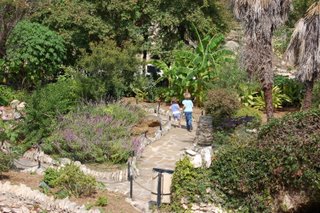 You Can Go Home
You Can Go HomeI was in San Antonio for the weekend of October 21. My younger sister, her husband and their two young children were also going to be in town so I figured it would be like a mini family reunion. There are many things I don't miss about Texas - mosquitos, rednecks,
trailer-trash, and the humidity in the summer. But I really miss tons of things, even the strange things like flash flooding, duallies, and cidadas. Then there are the fun things like Fiesta, NIOSA, birthday parties in the park with
piñatas, cascarones, and Dios de Los Muertos. I got my Tex-Mex food fix passified with trips to Panchitos for breakfast soft tacos and
Adelante's for puffy tacos. My family always makes eatting out a priority. Brunch at
The Guenther turned a bit nasty when I irked my sister so badly she snapped at me. I was getting surly with my mom because she was getting frustrated with the wait. I just don't handle waiting well. The sticky sweet rolls are great there.

The funniest place we went was the
Bass Pro Shop which had just opened. Picture a bunch of DubbaYa suporters in their cowboy boots, baseball caps, and denim-dressed wives dragging mini-me kids into the strange but engaging mix of
taxidermied animals and country-boy stuff for sale. They had everything imaginable that a Billy Bob or Ida Mae could ever dream of. The kids were eager to climb aboard the HUGE selection of boats, ATVs, and every other testosterone-filled big boy toy imaginable. Passing through Tammy Bahama shirts and fishing rods, we found our ways to the elevator that goes up behind the waterfall. Javelinas, diamondbacks, armadillos, bald eagles, and every creature that might have been on Noah's Arc was creepily stuffed and put on display to sell guns, bows, and gear used to take out any relatives they may have left alive in nature. The one glaring pose I had a probelm with was the pride of over five lions. The male lion had taken down the zebra, its throat clenched in his jaws. Excuse me! Wild Kingdom taught me one important thing about lionesses - they do the majority of the kills! Taxidermy chauvenism? First for me.

Well, I really enjoyed Brackenridge Park, the little train, and the Japanese Sunken Gardens despite the later's neglected state. It was fun to drive over the waterfall bridge just like when I was a kid. Went to El Mercado to pick up some glass light fixtures for my new home. All the alters and Dios de Los Muertos stuff was out like the sugar skulls. More great meals. My favorite meal was at
The Lodge in Castle Hills. It is in a beautiful old home that reminds me so much of San Antonio with its limestone walls surrounded by Spanish oak trees.
I also enjoyed seeing the rennovations friends were making to their
O'Neil Ford home near the Trinity campus. The lines and windows of the place are gorgeous. A&K are doing a fantastic job keeping the clean and modern look of the home with very stylish, modern updates that make it look fabulous and glamorous. I think their work should be in Architecture Digest once complete. They have a great sense of balance and aesthetic design. The pool and stairwell are my favorites. The pool is designed to pattern the horizontal lines of the home with a centered uplifted square for a heated jacuzzi that flows water over and into the main pool. The lifted square has iridescent blue small tiles that reminded me of paua shell from New Zealand. It nicely added color to the sandstone texture surrounding it. I can't wait to see the finished home.
 Harlem. Who wouldn't want to dress like this ? We walked down 125th St. and looped back to Grant's Tomb. The benches around that area were funtastical. We then hopped over to Riverside church and got caught up in the stained glass. We took a ride up to the 20th floor of the tower only to be kicked out by a security guard as Paul was trying to open a window so I could get a better photo. We didn't know it was a nesting perch for a redtail hawk.
Harlem. Who wouldn't want to dress like this ? We walked down 125th St. and looped back to Grant's Tomb. The benches around that area were funtastical. We then hopped over to Riverside church and got caught up in the stained glass. We took a ride up to the 20th floor of the tower only to be kicked out by a security guard as Paul was trying to open a window so I could get a better photo. We didn't know it was a nesting perch for a redtail hawk.



















